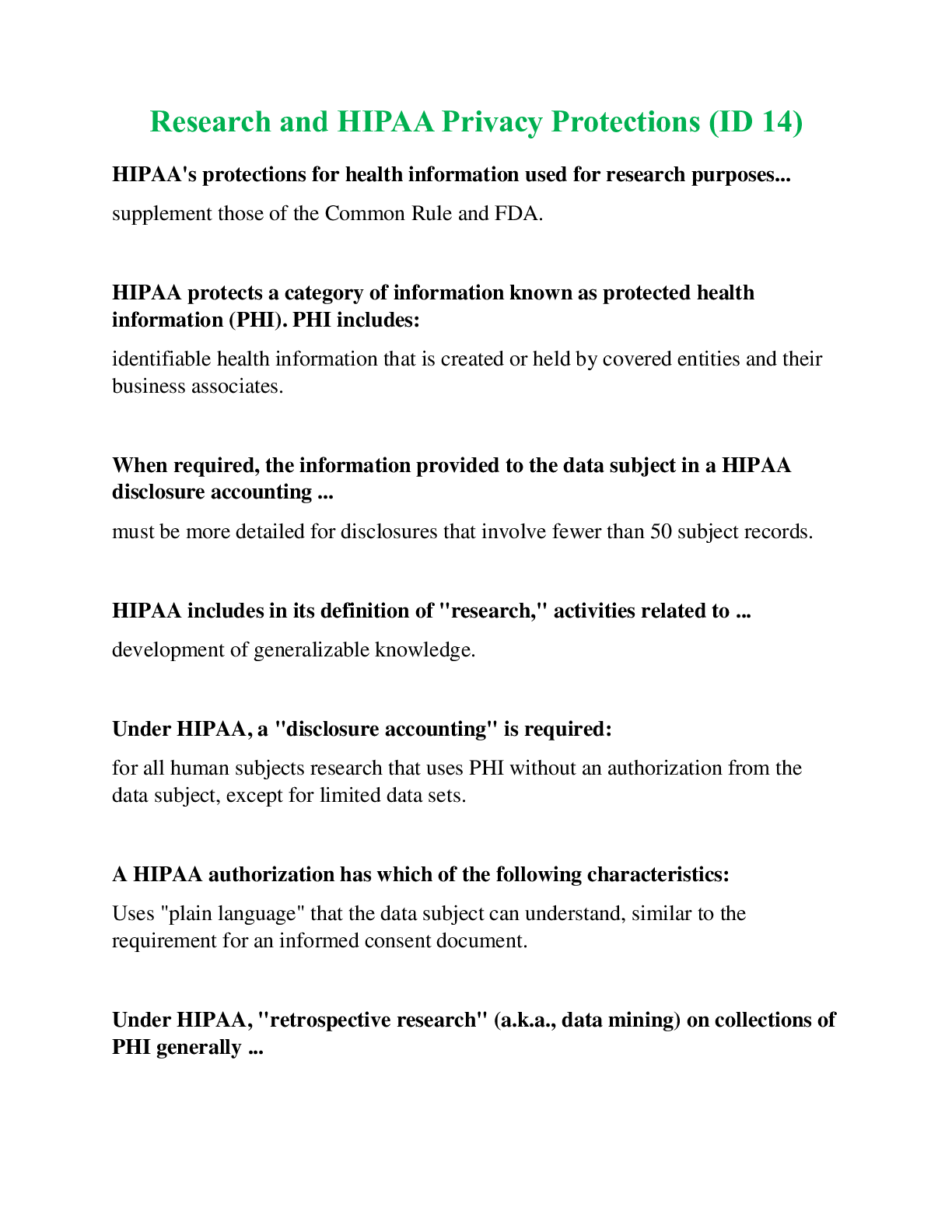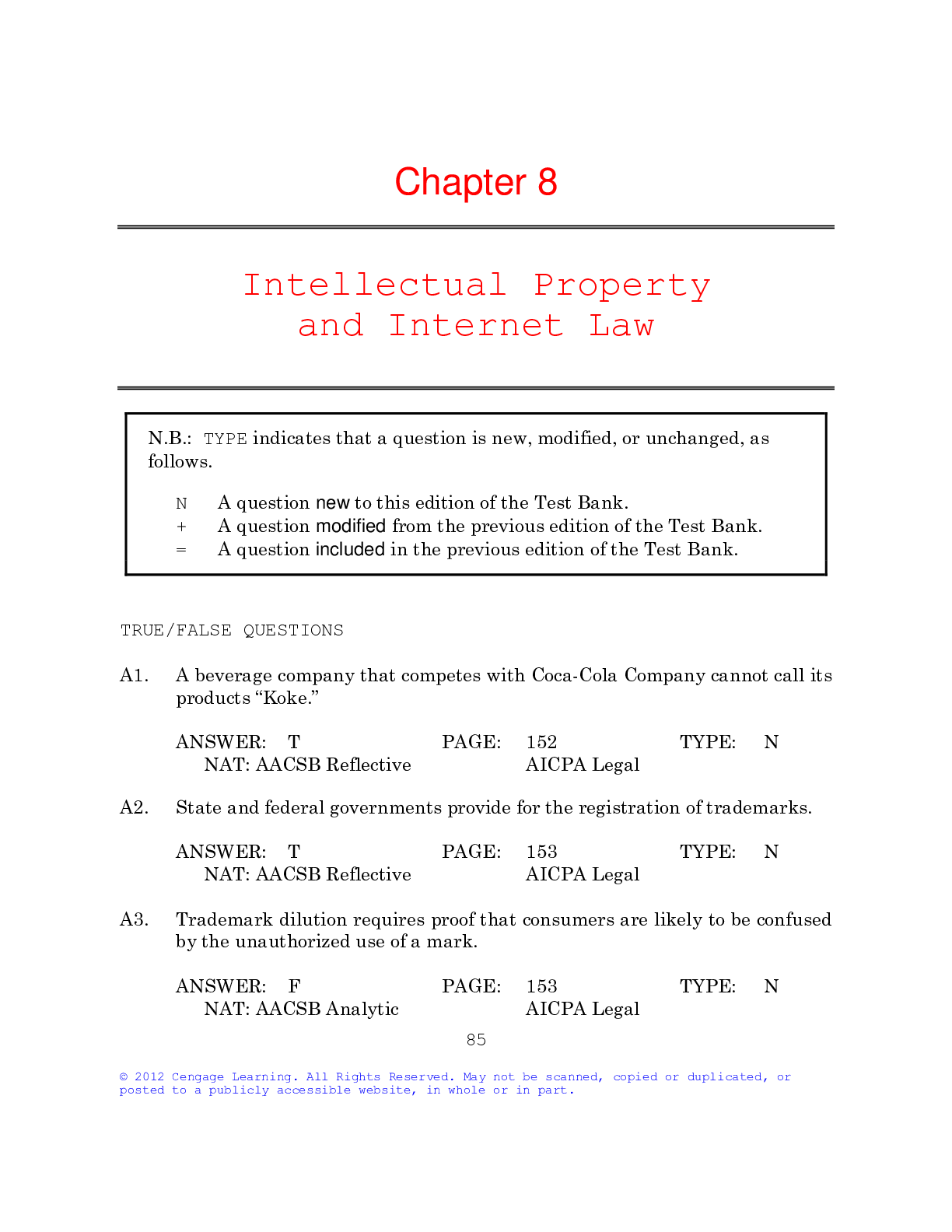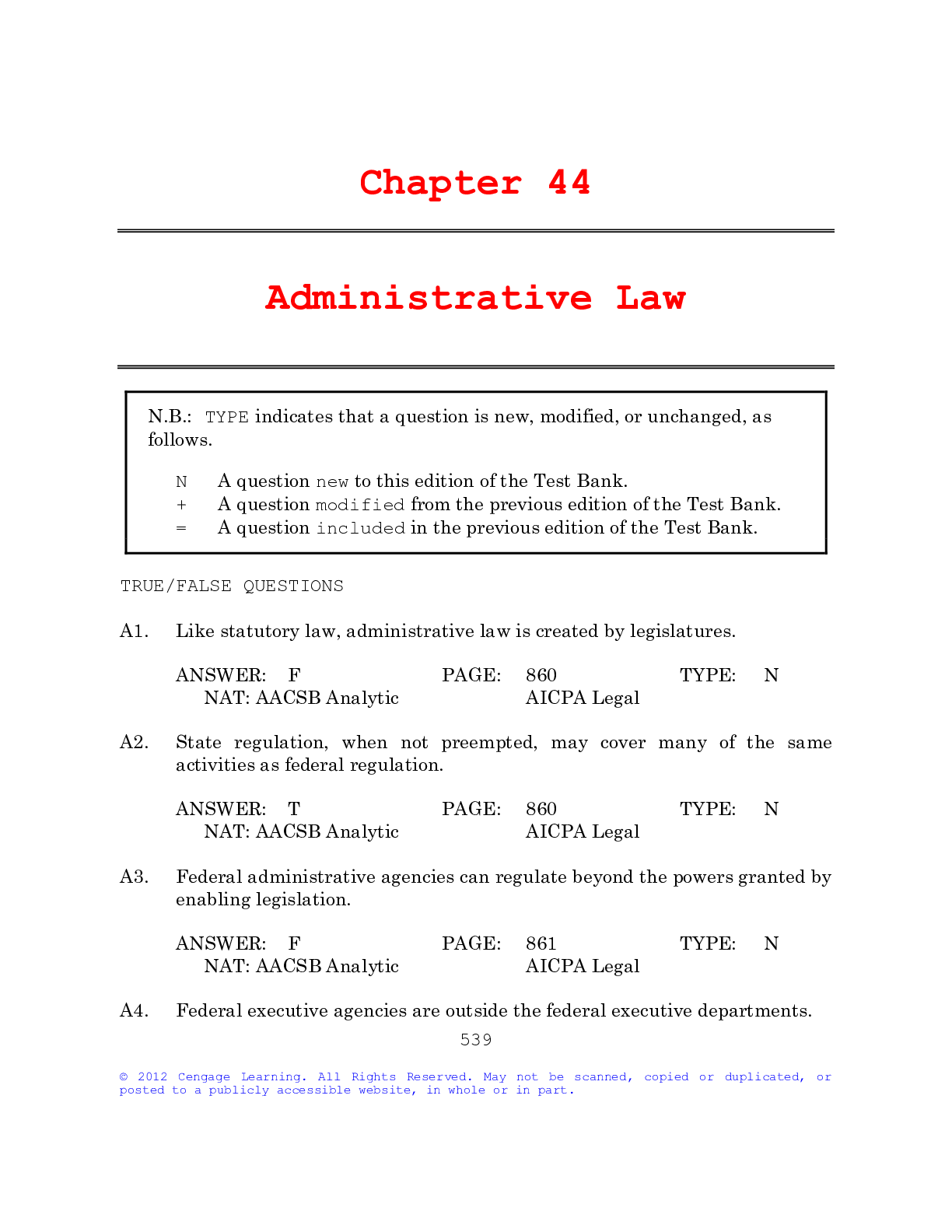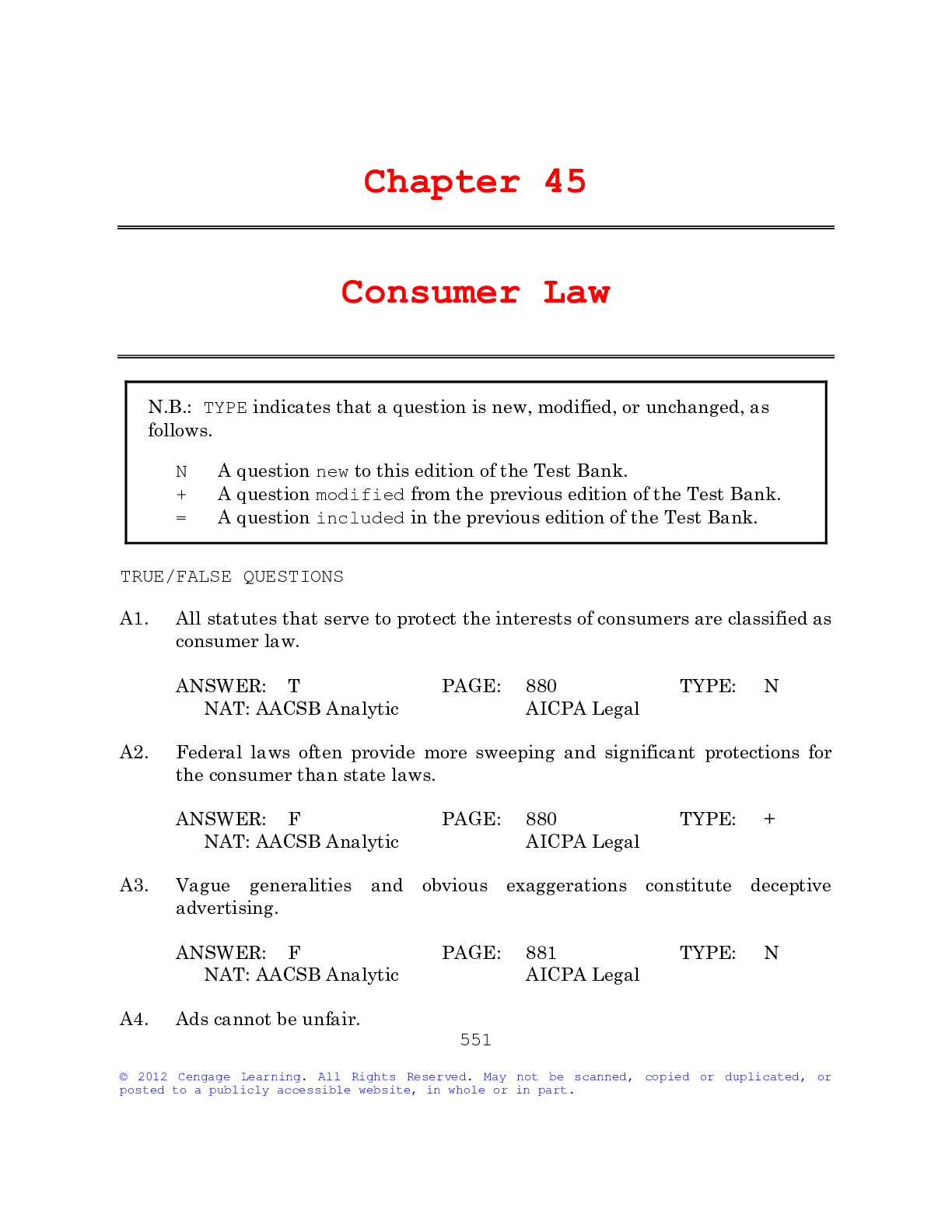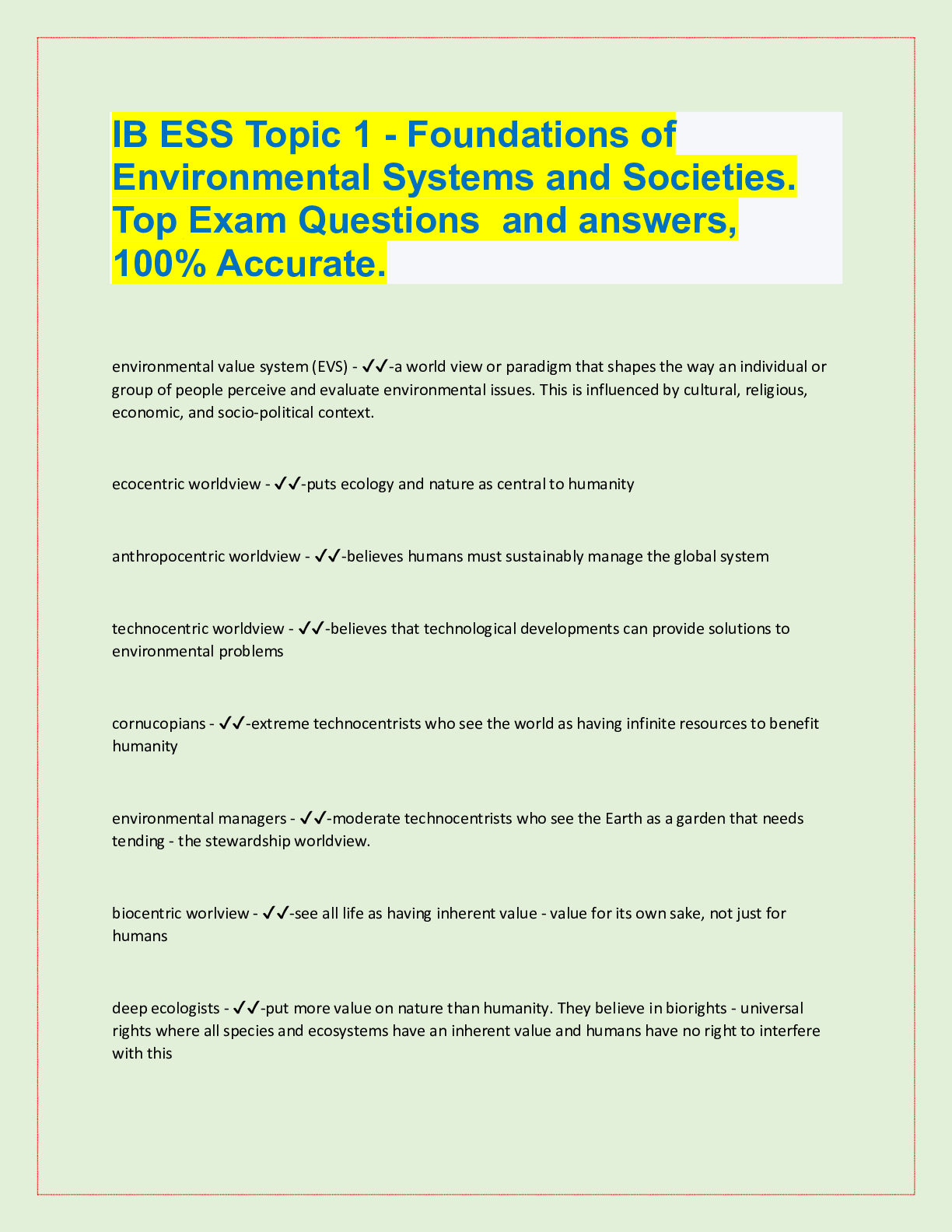Economics > QUESTIONS & ANSWERS > Chapter 46 Environmental Law. All Answers (All)
Chapter 46 Environmental Law. All Answers
Document Content and Description Below
N.B.: TYPE indicates that a question is new, modified, or unchanged, as follows. N A question new to this edition of the Test Bank. + A question modified from the previous edition of the Test Ban... k. = A question included in the previous edition of the Test Bank. TRUE/FALSE QUESTIONS A1. All environmental law consists of statutes and regulations. F PAGE: 897 TYPE: N NAT: AACSB Analytic AICPA Legal A2. Under the common law doctrine of nuisance, persons may be liable if they file a suit against a business polluter that views the suit as a nuisance. F PAGE: 897 TYPE: N NAT: AACSB Analytic AICPA Legal A3. State laws may restrict a business’s discharge of chemicals into the air or water. T PAGE: 898 TYPE: N NAT: AACSB Analytic AICPA Legal A4. States may restrict emissions from motor vehicles. T PAGE: 898 TYPE: N NAT: AACSB Analytic AICPA Legal A5. An environmental impact statement is required for every major federal action that significantly affects the quality of the environment. T PAGE: 898 TYPE: N NAT: AACSB Analytic AICPA Legal A6. Federal statutes and regulations do not cover mobile sources of air pollution. F PAGE: 899 TYPE: + NAT: AACSB Analytic AICPA Legal A7. The Environmental Protection Agency periodically updates the pollution standards. T PAGE: 899 TYPE: N NAT: AACSB Analytic AICPA Legal A8. There are no plans to develop national standards regulating the fuel economy and emissions for medium- and heavy-duty trucks. F PAGE: 899 TYPE: N NAT: AACSB Analytic AICPA Legal A9. The primary responsibility for implementing air-quality standards rests with the federal government. F PAGE: 900 TYPE: + NAT: AACSB Analytic AICPA Legal A10. Only the Environmental Protection Agency can sue violators of emission limits under the Clean Air Act. F PAGE: 901 TYPE: N NAT: AACSB Analytic AICPA Critical Thinking A11. Different standards for air quality apply to existing sources of pollution and major new sources. T PAGE: 901 TYPE: + NAT: AACSB Analytic AICPA Legal A12. Corporate officers cannot be subject to penalties for violations of the Clean Air Act. F PAGE: 901 TYPE: N NAT: AACSB Analytic AICPA Legal A13. Any point source emitting pollutants into water must have a permit. T PAGE: 902 TYPE: N NAT: AACSB Analytic AICPA Legal A14. The Clean Water Act includes special provisions for toxic chemicals and for oil spills. T PAGE: 902 TYPE: N NAT: AACSB Analytic AICPA Legal A15. New sources of water pollutants must install pollution-control equip¬ment before beginning operations. T PAGE: 902 TYPE: N NAT: AACSB Analytic AICPA Legal A16. The Environmental Protection Agency defines wetlands as “lands that are wet.” F PAGE: 904 TYPE: N NAT: AACSB Analytic AICPA Legal A17. States have the primary responsibility for enforcing the permit system for point-source water pollution control. T PAGE: 905 TYPE: N NAT: AACSB Analytic AICPA Legal A18. The Environmental Protection Agency sets minimum levels for pollut¬ants in public water systems. F PAGE: 906 TYPE: N NAT: AACSB Analytic AICPA Legal A19. The Environmental Protection Agency can regulate a substance that poses an imminent hazard but cannot prohibit the use of a substance altogether. F PAGE: 907 TYPE: N NAT: AACSB Analytic AICPA Legal A20. The government can recover the cost to clean up a hazardous waste dis¬posal site from the persons who were even remotely responsible. T PAGE: 908 TYPE: N NAT: AACSB Analytic AICPA Legal MULTIPLE CHOICE QUESTIONS A1. Fabio makes a living by farming near Gastric Combustibles, Inc., which has discharged pollutants into the area’s air and water. In a suit by Fabio for an injunction against Gastric on the ground of nuisance, the court is most likely to rule in Gastric’s favor if a. Fabio’s operation also pollutes, with pesticides and herbicides. b. Fabio’s operation suffers harm distinct from the general public. c. Gastric’s operation is the core of the local economy. d. Gastric’s operation uses reasonable care to avoid harm to Fabio. C PAGE: 897 TYPE: = NAT: AACSB Reflective AICPA Legal A2. Consolidated Trucking Company transports radioactive materials. Darla suffers from cancer. To succeed in a suit against Consolidated on the ground of strict liability, Darla must show that her injury was caused by a. Consolidated’s failure to use reasonable care to avert herm to Darla. b. Consolidated’s intentional lack of regard for the general public. c. Consolidated’s operation. d. radiation from any source. C PAGE: 897 TYPE: = NAT: AACSB Reflective AICPA Legal A3. Valley Disposal Center operates a recycling plant. Wendy and other Valley neighbors file a suit, alleging injuries from the plant. To succeed, they must show that Valley failed to use reasonable care if the suit is based on a. a negligence theory. b. a nuisance theory. c. any legal theory. d. a strict liability theory. A PAGE: 897 TYPE: = NAT: AACSB Reflective AICPA Legal A4. Congress enacts air quality legislation. To implement and enforce this law, as is typical of other environmental statutes and regulations, the federal government will most likely rely on a. all levels of government. b. local chambers of commerce. c. local police departments. d. polluters’ self-monitoring. A PAGE: 898 TYPE: + NAT: AACSB Reflective AICPA Legal A5. The Environmental Protection Agency (EPA) has the authority to regu¬late “any air pollutant.” Fresher Air Group, a private organization, sup¬ports cleaner air. Fresher Air can file a suit against the EPA to a. compel the EPA to act only. b. compel the EPA to act or prevent it from acting. c. neither compel the EPA to act nor prevent it from acting. d. prevent the EPA from acting only. B PAGE: 898 TYPE: = NAT: AACSB Reflective AICPA Legal A6. Ski Resorts, Inc., wants to add a new run to its facility in a national park on federal land. For this action, an environmental impact statement is a. prohibited. b. required. c. unnecessary. d. voluntary. B PAGE: 898 TYPE: = NAT: AACSB Reflective AICPA Legal A7. Truckers Storage Depot, a private company, wants to build a ware¬house on private land. For this action, an environmental impact state¬ment is a. prohibited. b. required. c. unnecessary. d. voluntary. C PAGE: 898 TYPE: = NAT: AACSB Reflective AICPA Legal A8. Metal Smelting, Inc., operates a plant—a “major source”—that emits hazardous air pollutants for which the Environmental Protection Agency has set maximum levels of emission. The plant does not use any equipment to reduce its emissions. Under the Clean Air Act, this is most likely a. a violation. b. not a violation because a “major source” is exempt. c. not a violation because the plant does not use any equipment. d. not a violation because the plant is not a mobile source. A PAGE: 901 TYPE: N NAT: AACSB Reflective AICPA Legal A9. Industrial Solvents, Inc., averages $15,000 profit per day before deciding to ignore air pollution standards, after which the average is $30,000. Industrial Solvents is subject to a fine of a. $0. b. $15,000 per day. c. $30,000 per day. d. $30,000 total. C PAGE: 901 TYPE: = NAT: AACSB Reflective AICPA Legal A10. Quickly Motor Company makes the Rock, a new model of sport utility ve-hicle, and sells it at the market’s lowest price. The Rock does not, how¬ever, satisfy federal emission standards and Quickly fails to maintain relevant, required records. The Environmental Protection Agency may assess a. civil penalties, additional fines, and criminal penalties. b. civil penalties and additional fines only. c. civil penalties only. d. criminal penalties, including fines and imprisonment, only. A PAGE: 901 TYPE: = NAT: AACSB Reflective AICPA Legal A11. Fried Food, Inc., operates a commercial frying plant, discharging pol¬lut¬ants into the air. Greg reports the violations to the Environmental Protection Agency. Greg a. is not entitled to a payment. b. may be paid up to any amount. c. may be paid up to $1,000. d. may be paid up to $10,000. D PAGE: 901 TYPE: = NAT: AACSB Reflective AICPA Legal A12. A barge owned by Oceanic Shipping Company accidentally runs aground, spilling the oil contained in its hold into the sea and onto the shore. Under the Clean Water Act, this is most likely a. a violation. b. not a violation because an oil spill is an accident. c. not a violation because a floating barge is not a stationary source. d. not a violation because a ship’s hold is not a point source. A PAGE: 902 TYPE: N NAT: AACSB Reflective AICPA Legal A13. Video Products Company operates a DVD manufacturing plant on Wandering River. Discharging pollutants from the plant into the river can re¬sult in a. civil penalties and criminal penalties. b. civil penalties only. c. criminal penalties only. d. no penalties. A PAGE: 905 TYPE: = NAT: AACSB Reflective AICPA Legal A14. Metro City operates its own municipal public drinking water system for which the Environmental Protection Agency has set maximum levels of pollutants. Metro does not use any equipment to meet these standards. With regard to any contamination of the water, under the Safe Drinking Water Act, this is most likely a. a violation. b. not a violation because Metro does not set the standards. c. not a violation because water is not a stationary source. d. not a violation because Metro does not use any equipment. A PAGE: 906 TYPE: N NAT: AACSB Reflective AICPA Legal A15. Under the Marine Protection, Research, and Sanctuaries Act (the Ocean Dumping Act), Bayside Chemical Company may dump its chemical waste into the ocean a. after obtaining a permit. b. before obtaining a permit. c. without a permit. d. not at all. D PAGE: 906 TYPE: = NAT: AACSB Reflective AICPA Legal A16. Fruitful Garden Company makes and sells pesticides. For the pesticides to remain on the market, the acceptable level of risk to people of develop¬ing cancer from ex¬posure to the products is a. one-in-a-hundred. b. one-in-a-million. c. one-in-a-thousand. d. zero. B PAGE: 907 TYPE: = NAT: AACSB Reflective AICPA Legal A17. ChemoCorp, Inc., makes and sells pesticides. If a substance is identified as harmful and the harm is imminent, the Environmental Protection Agency can a. conduct an inspection of ChemoCorp’s plant. b. declare the substance to be unregulated and allow its production. c. ignore the risk if the benefit outweighs the harm. d. order the substance to be sold in an adulterated form. A PAGE: 907 TYPE: = NAT: AACSB Reflective AICPA Legal A18. Industry Processes Corporation generates solid waste considered haz¬ardous. Industry labels and packages properly all waste to be trans¬ported to a disposal site. Under the Resource Conservation and Recovery Act, this is most likely a. not a violation. b. a violation because Industry generates solid waste. c. a violation because the waste is transported off-site. d. a violation because the waste is considered hazardous. B PAGE: 907 TYPE: N NAT: AACSB Communication AICPA Legal A19. Before being transported, hazardous waste generated by Xtreme Industries, Inc., must be properly labeled and packaged under the Resource Conservation and Recovery Act by a. the federal Environmental Protection Agency. b. the local Resource Conservation and Recovery Committee. c. the state Environmental Regulatory Commission. d. Xtreme Industries, Inc. D PAGE: 907 TYPE: = NAT: AACSB Reflective AICPA Legal A20. United Disposal, Inc., operates a hazardous waste disposal site that ac¬cepts waste transported by Ace Trucking Company from General Manufacturing Corporation. United sells the site to Investment Properties, Inc. A release of the waste is discovered at the site, and the Environmental Protection Agency (EPA) cleans it up. The EPA can re¬cover the cost of the cleanup from a. United only. b. United or General only. c. United, General, or Ace only. d. United, General, Ace, or Investment Properties. D PAGE: 908 TYPE: = NAT: AACSB Reflective AICPA Legal ESSAY QUESTIONS A1. Cozy City lies on the shore of a bay that empties into the Atlantic Ocean. Downcycler Waste Company picks up garbage and trash from local busi-nesses. Further inland, Eschew Corporation collects radioactive waste from the local utility’s nuclear power plant. On the other side of the bay, Fort Cozy Military Base stores chemical warfare supplies for disposal. Can Downcycler, Eschew, or Fort Cozy dump their waste in the ocean? A2. Odiferous Waste Company is a subsidiary of Precarious Investments, Inc. Odiferous op¬erates a hazardous waste disposal site. QuikChem Corporation is one of many parties who generate waste disposed of at the site. Odiferous borrows money from Regal Bank, which takes over the site when Odiferous goes bankrupt. The Environmental Protection Agency discov¬ers a leak at the site. Can any of these private parties be forced to pay for the clean up? If so, who? [Show More]
Last updated: 1 year ago
Preview 1 out of 16 pages

Buy this document to get the full access instantly
Instant Download Access after purchase
Add to cartInstant download
We Accept:

Reviews( 0 )
$7.00
Document information
Connected school, study & course
About the document
Uploaded On
Jan 03, 2020
Number of pages
16
Written in
Additional information
This document has been written for:
Uploaded
Jan 03, 2020
Downloads
0
Views
58

